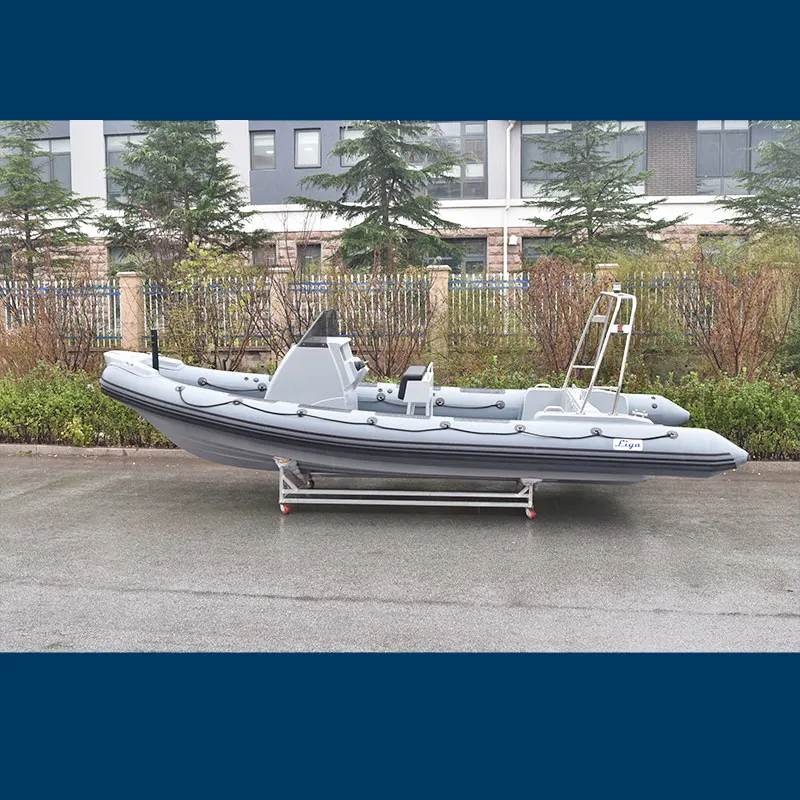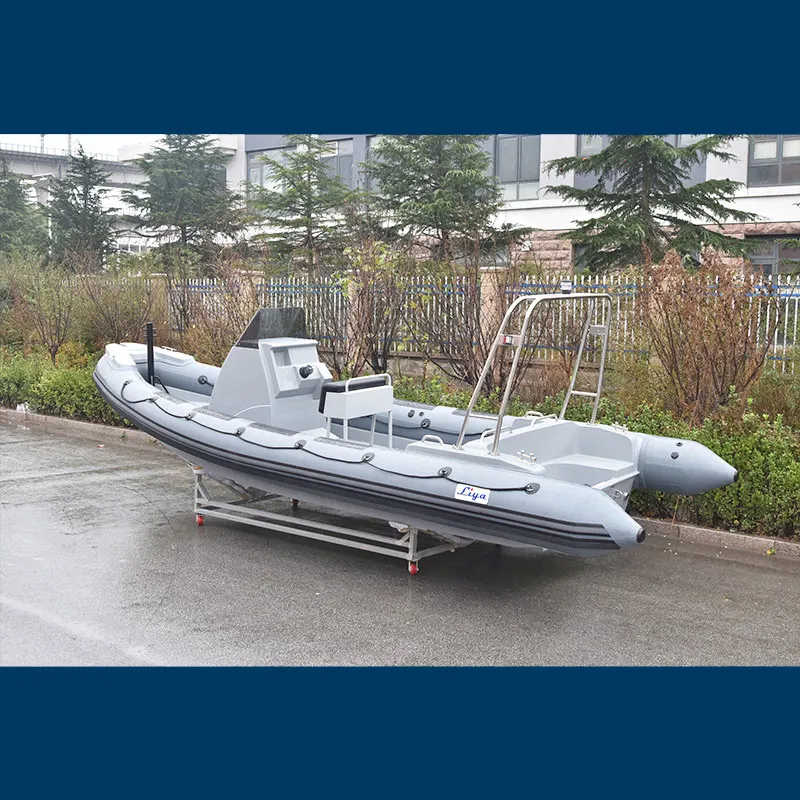De voordelen van het gebruik van Navy RHIB's bij moderne maritieme missies
In het zich ontwikkelende landschap van moderne maritieme oorlogvoering is de vraag naar snelle, betrouwbare en veelzijdige schepen zo hoog als nooit tevoren. Marine rhibs —Starre huid-inflatieboten—zijn cruciale onderdelen geworden in maritieme operaties wereldwijd. Wat geeft deze compacte boten zo'n essentiële rol? Waarom worden RHIB's door marine-eenheden telkens opnieuw gekozen voor missies waarbij prestaties en precisie van groot belang zijn?
Laten we de strategische, operationele en technologische voordelen verkennen die ervoor zorgen dat marine RHIB's onmisbaar zijn in de huidige marineomgeving.
Tactische flexibiliteit voor meerdere missies
Een standaardplatform voor speciale operaties
Marine rhibs zijn een uitstekende keuze voor speciale eenheden vanwege hun sluipprofiel, lage diepgang en snelle inzetbaarheid. Of het nu gaat om het inbrengen van een verkenningsploeg of het uitvoeren van een evacuatie onder dekking van de duisternis, deze boten bieden ongeëvenaarde toegang tot ondiep en beperkt vaarwater. Operatoren kunnen ze lanceren vanaf grotere schepen, vliegtuigen of kustbases, waardoor ze geschikt zijn voor vrijwel elk missietype.
Hun hoge wendbaarheid en stille voortbewegingsmodi zorgen er ook voor dat marine RHIB's onopgemerkt dicht bij vijandelijk gebied kunnen komen, waardoor de effectiviteit van geheime operaties aanzienlijk wordt verhoogd.
Ideaal voor maritieme tegenhouding en patrouille
Maritieme tegenhouding vereist snelheid, wendbaarheid en precisie. Marine RHIB's zijn uitstekend geschikt voor het onderscheppen van kleine, snel rijdende vaartuigen die worden gebruikt voor smokkel, piraterij of ongeautoriseerde grensoverschrijdingen. Hun compacte afmetingen maken het mogelijk om in de buurt van de kust of in smalle vaarwegen te opereren, waar grotere schepen niet kunnen manoeuvreren.
Uitrusting met geavanceerde surveillanceapparatuur en krachtige motoren zorgt ervoor dat Navy RHIBs lange patrouilleduren kunnen ondersteunen, terwijl ze snelheid en responsiviteit behouden tijdens plotselinge confrontaties.

Operationele veerkracht in extreme omstandigheden
Uitstekende prestaties in uitdagende omgevingen
Hoe presteren Navy RHIBs in ruwe zeeën of onvoorspelbaar weer? Hun ontwerp spreekt voor zich. Voorzien van een diep-V-hull en opblaasbare zijden bieden Navy RHIBs uitstekende schokabsorptie en uitstekende zeegaang-eigenschappen. Dit maakt stabiele navigatie mogelijk in golven tot 4 meter hoog, waardoor ze ideaal zijn voor zowel kust- als offshore-operaties.
Bovendien zorgt hun verbeterde stabiliteit ervoor dat apparatuur aan boord kan worden gebruikt tijdens beweging, waardoor real-time communicatie, doelwitvolging of medische hulp mogelijk is tijdens noodgevallen.
Gebouwd voor lange levensduur
Navy RHIB's zijn niet alleen snelheid - ze zijn gebouwd om te blijven. Materialen zoals Hypalon en aluminium van marienekwaliteit zorgen voor weerstand tegen corrosie door zout water, UV-straling en fysieke impact. In extreme omgevingen - van de ijskoude Noord-Atlantische Oceaan tot tropische wateren - behouden deze boten gedurende jaren hun operationele betrouwbaarheid.
Onderhoud is eenvoudig en modulaire componenten vereenvoudigen reparaties en upgrades, waardoor de stilstandstijd en levenscycluskosten worden verlaagd.
Integratie van geavanceerde technologieën
Naadloze navigatie- en communicatiesystemen
Moderne Navy RHIB's zijn uitgerust met GPS/INS hybride navigatie, communicatiesystemen op lange afstand en mogelijkheden voor het delen van realtime gegevens. Deze functies zorgen ervoor dat ze volledig interoperabel zijn met grotere vlootsystemen, onbemande luchtvaartuigen (UAV's) en commandocentra.
In missie-critische situaties geeft het in stand houden van connectiviteit en situatiewaarneming over platforms heen Navy RHIB's een beslissend voordeel.
Aanpasbare modulaire platforms
Kan één boot verschillende missietypes uitvoeren? Met Navy RHIBs is het antwoord ja. Modulaire dekopstellingen maken het mogelijk om snel wapeninstallaties, medische uitrusting, sonarsystemen of dronebesturingsinterfaces te monteren. Deze aanpasbaarheid maakt het mogelijk om binnen uren een andere configuratie te kiezen en de boot voor geheel andere missies voor te bereiden, zonder dat het vaartuig vervangen hoeft te worden.
Een dergelijke veelzijdigheid draagt niet alleen bij aan een efficiëntere vloot, maar ondersteunt ook een breed scala aan operaties - vanaf gevechtssituaties tot humanitaire hulpverlening.
Kosteneffectiviteit en inzetbaarheid
Lagere aanschaf- en onderhoudskosten
Vergelijken met grotere marineschepen bieden Navy RHIBs een aanzienlijk lagere eigendomskost. De initiële aanschaf is betaalbaar en hun lichte constructie betekent dat ze minder brandstof en onderhoud nodig hebben. Over een levenscyclus van 10 à 15 jaar bedraagt de totale operationele kost slechts een fractie van die van traditionele snelle patrouilleschepen.
Marine RHIB's vereisen ook kleinere bemanningen, waardoor opleidingskosten en personeelsrisico's tijdens missies met hoge inzet afnemen.
Gemakkelijke transport en snelle inzet
Tijdgevoelige missies zijn afhankelijk van een snelle respons. Marine RHIB's zijn luchttransporteerbaar en kunnen worden ingezet via helikopters, vrachtvliegtuigen of schipkranen. Hun lage gewicht en compacte vorm zorgen voor snelle laadtijden en uitladen, waardoor de missieklaarheid met minimale infrastructuur wordt vergemakkelijkt.
Of ze nu opereren in afgelegen gebieden of in drukke maritieme zones, marine RHIB's kunnen ter plaatse zijn en binnen recordtijd volledig operationeel zijn.
Strategische rol in gezamenlijke maritieme operaties
Verbetering van interoperabiliteit en coalitieondersteuning
Bij gezamenlijke maritieme missies met betrekking tot multinationale strijdkrachten is interoperabiliteit essentieel. Marine RHIB's zijn compatibel met NAVO-standaarden en wijdverspreide communicatieprotocollen. Dit garandeert naadloze coördinatie met andere schepen, vliegtuigen en commandounits.
Marine RHIB's worden vaak ingezet als snelle reactiemiddelen die grotere platforms en personeel met elkaar verbinden, waardoor de snelheid en samenhang van complexe maritieme strategieën worden verbeterd.
Ondersteuning van humanitaire hulp en rampenbestrijding
Naast strijdtaken worden Navy RHIB's steeds vaker gebruikt voor humanitaire hulp en rampenbestrijding. Hun wendbaarheid stelt hen in staat gebieden te bereiken die voor grotere schepen ontoegankelijk zijn, waardoor voorraden kunnen worden geleverd of gewonde burgers geëvacueerd. Hun betrouwbaarheid in ruwe omstandigheden zorgt voor onafgebroken werking, zelfs wanneer weer of terrein extra uitdagingen oplevert.
FAQ
Waar worden Navy RHIB's voor gebruikt in marineoperaties?
Navy RHIB's worden gebruikt voor een breed scala aan missies, waaronder speciale operaties, zoek- en reddingsacties, maritieme tegenhouding, kustbewaking en snelle troepeninzet. Hun snelheid, stabiliteit en aanpasbaarheid maken ze geschikt voor zowel strijd- als humanitaire taken.
Hoe presteren Navy RHIBs in ruwe zeetoestanden?
Dankzij hun stijve romp en opblaasbare boegontwerp kunnen marine RHIB's navigeren in hoge zeeën met uitstekende stabiliteit. Ze zijn ontworpen om effectief te opereren in golven tot 4 meter en kunnen snelheid en controle behouden, zelfs in turbulente wateren.
Zijn marine RHIB's kostenefficiënt voor langdurig maritiem gebruik?
Ja, marine RHIB's bieden lage aanschaf- en levenscycluskosten. Hun duurzame constructie, modulaire upgrades en minimale onderhoudsbehoefte dragen bij aan langtermijnsbesparing, waardoor ze een economische keuze zijn voor moderne marines.
Kunnen marine RHIB's worden aangepast aan verschillende missie-eisen?
Absoluut. Marine RHIB's ondersteunen modulaire configuraties die snel kunnen worden aangepast voor verschillende rollen, waaronder strijdondersteuning, medische evacuatie, inlichtingenverzameling en logistieke bevoorrading. Deze flexibiliteit verhoogt de operationele gereedheid zonder uitbreiding van de vlootgrootte.
Inhoudsopgave
- De voordelen van het gebruik van Navy RHIB's bij moderne maritieme missies
- Tactische flexibiliteit voor meerdere missies
- Operationele veerkracht in extreme omstandigheden
- Integratie van geavanceerde technologieën
- Kosteneffectiviteit en inzetbaarheid
- Strategische rol in gezamenlijke maritieme operaties
- FAQ

